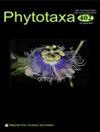Candolle was wrong, but finally right: Polygala ovata belongs to Hebecarpa (Polygalaceae)
IF 1
4区 生物学
Q3 PLANT SCIENCES
引用次数: 0
Abstract
A comprehensive review of the name Polygala ovata Poiret (1804), basionym of the widely used Asemeia ovata, revealed strong evidence to an alternative interpretation of this name as used by Pastore and Abbott in their Asemeia treatment in 2012. Issues arise from discrepancies between Poiret’s identification in specimens kept in P herbarium as P. ovata, and the original specimen of Nectoux from the Dominican Republican. De Candolle promoted the first attempted to resolve the application of Polygala ovata, however he had different approaches, when included this name in Prodromus, and later in the specimen identification as P. ovata. The present study reevaluates P. ovata identity based on original herbarium specimens, protologue information and original morphological description. The evidence found supports reclassifying P. ovata as a member of genus Hebecarpa instead, and therefore a new combination is proposed here, along with a morphological plate and taxonomic and distribution notes.Candolle 错了,但最终还是对了:卵形远志属于远志科(Hebecarpa)。
对被广泛使用的 Asemeia ovata 的别名 Polygala ovata Poiret(1804 年)进行全面审查后发现,有强有力的证据表明 Pastore 和 Abbott 在 2012 年处理 Asemeia 时对该名称进行了另一种解释。Poiret 在标本馆保存的标本中鉴定为 P. ovata,而 Nectoux 的原始标本来自多米尼加共和国,两者之间的差异引起了问题。德-坎多勒(De Candolle)是第一个尝试解决卵形远志应用问题的人,但他在将这一名称纳入《Prodromus》和后来将标本鉴定为卵形远志时采用了不同的方法。本研究根据原始标本馆标本、原生资料和原始形态描述,重新评估了卵形远志的身份。发现的证据支持将 P. ovata 重新归类为 Hebecarpa 属的成员,因此在此提出了一个新的组合,并附有形态图版以及分类和分布说明。
本文章由计算机程序翻译,如有差异,请以英文原文为准。
求助全文
约1分钟内获得全文
求助全文
来源期刊

Phytotaxa
PLANT SCIENCES-
CiteScore
1.90
自引率
27.30%
发文量
956
审稿时长
1 months
期刊介绍:
Phytotaxa is a peer-reviewed, international journal for rapid publication of high quality papers on any aspect of systematic and taxonomic botany, with a preference for large taxonomic works such as monographs, floras, revisions and evolutionary studies and descriptions of new taxa. Phytotaxa covers all groups covered by the International Code of Nomenclature foralgae, fungi, and plants ICNafp (fungi, lichens, algae, diatoms, mosses, liverworts, hornworts, and vascular plants), both living and fossil. Phytotaxa was founded in 2009 as botanical sister journal to Zootaxa. It has a large editorial board, who are running this journal on a voluntary basis, and it is published by Magnolia Press (Auckland , New Zealand). It is also indexed by SCIE, JCR and Biosis.
All types of taxonomic, floristic and phytogeographic papers are considered, including theoretical papers and methodology, systematics and phylogeny, monographs, revisions and reviews, catalogues, biographies and bibliographies, history of botanical explorations, identification guides, floras, analyses of characters, phylogenetic studies and phytogeography, descriptions of taxa, typification and nomenclatural papers. Monographs and other long manuscripts (of 60 printed pages or more) can be published as books, which will receive an ISBN number as well as being part of the Phytotaxa series.
 求助内容:
求助内容: 应助结果提醒方式:
应助结果提醒方式:


